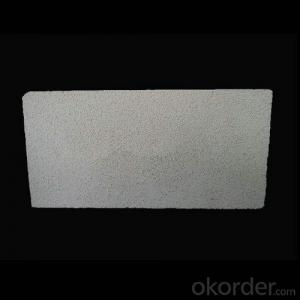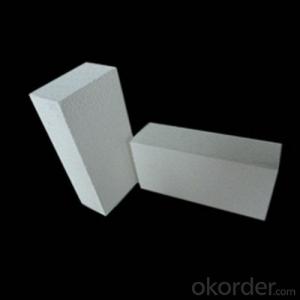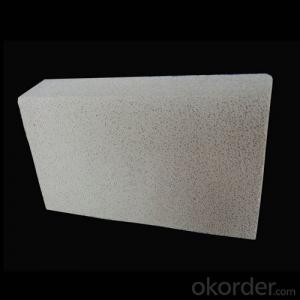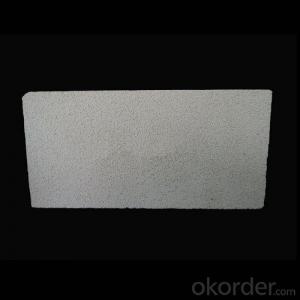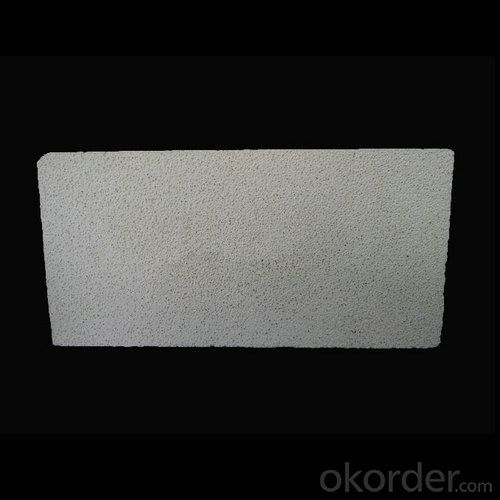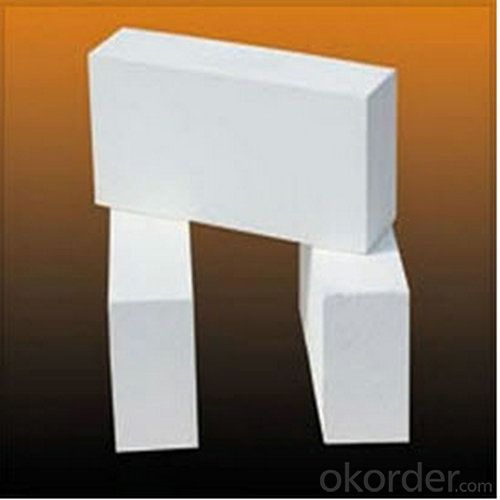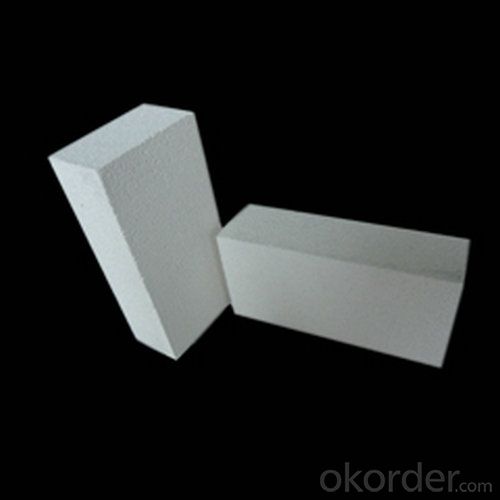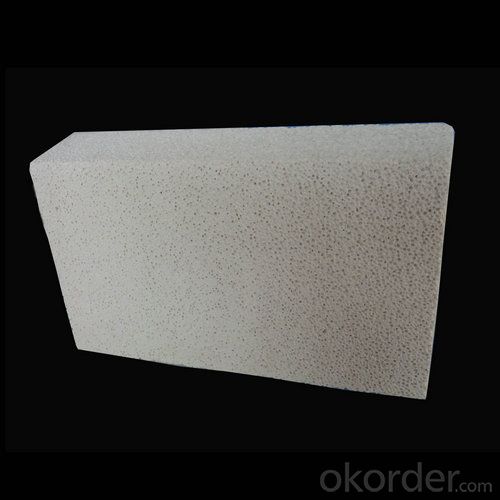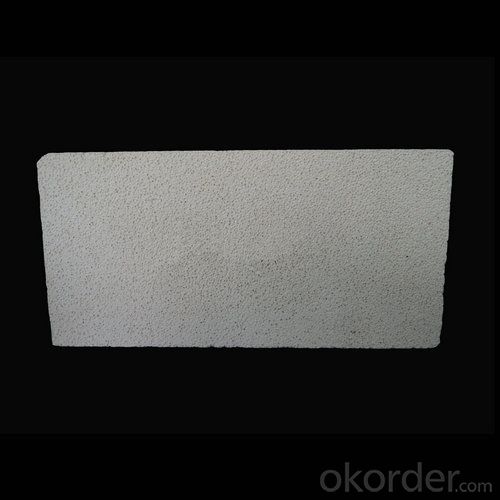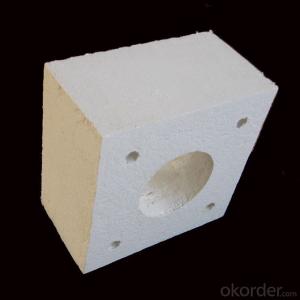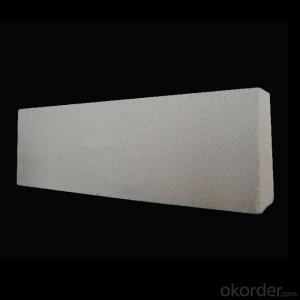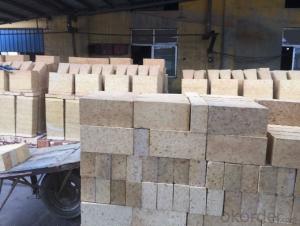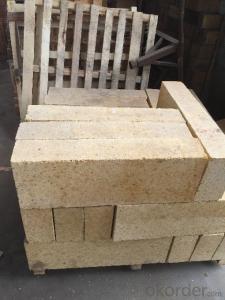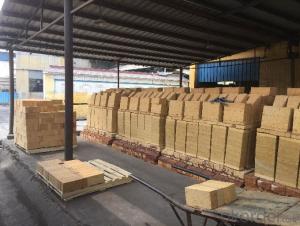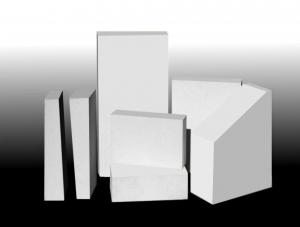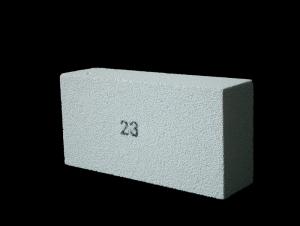Insulating Fire Brick 65% Al2O3 min High Alumina
- Loading Port:
- Tianjin
- Payment Terms:
- TT OR LC
- Min Order Qty:
- 1 m.t.
- Supply Capability:
- 20000 m.t./month
OKorder Service Pledge
OKorder Financial Service
You Might Also Like
Description of Insulating Fire Brick
Insulating Fire Brick 65% Al2O3 min High Alumina is a kind of insulation material adopting organic matter as ignition loss substance in order to increase the porosity of refractory, which has such advantages as high porosity, small volume density, good insulation effect, high mechanical intensity, small thermal conductivity and long service life. For various industrial kilns & furnaces, Insulating Fire Brick is a kind of essential refractory for energy saving and temperature preservation.
This series of High Alumina Insulating Fire Brick are made of selected high alumina bauxite, kaolin caly, hollow microsphere as the mian material. By shaping at high pressure and sintering at high temperature.
Features of Insulating Fire Brick
1. Lower content of iron, alkaline and impurities, good high temperature properties.
2. Homogeneous structure, light weight, energy saving because lower heat storage in the furnace during cooling cycles.
3. High strength, good thermal shock resistance under high temperature.
4. Precise sizes due to grinding and shaping after firing, which meets the requirement of construction.
Specifications for Insulating Fire Brick
SSW-23 | SSW-25 | SSW-26 | SSW-28 | SSW-30 | SSW-32 | ||
ASTM C155-97 °C Classification Temperature °F | 1260 2300 | 1350 2500 | 1430 2600 | 1540 2600 | 1650 3000 | 1760 3200 | |
ASTM C134-95 g/cm³ Bulk Density ib/ft³ | 0.60 37 | 0.80 50 | 0.80 50 | 0.90 56 | 1.03 64 | 1.25 78 | |
ASTM C133-97 Mpa Cold Crushing Strength ib/in² | 1.2 170 | 2.0 284 | 2.0 284 | 2.6 370 | 2.8 398 | 3.4 484 | |
ASTM C133-97 Mpa Modulus of rupture ib/in² | 0.9 128 | 1.2 170 | 1.5 218 | 1.6 232 | 1.7 247 | 2.0 290 | |
ASTM C210-95 % Permanent Liner Change °C*hrs | 0 1230*24 | -0.5 1350*24 | -0.5 1400*24 | -0.8 1510*24 | -0.9 1620*24 | -0.9 1730*24 | |
ASTM C182-88 Thermal Conductivity (W/m.k) | 400°C | 0.17 | 0.24 | 0.24 | 0.30 | 0.40 | 0.49 |
600°C | 0.19 | 0.28 | 0.27 | 0.32 | 0.42 | 0.50 | |
800°C | 0.22 | 0.32 | 0.30 | 0.35 | 0.44 | 0.51 | |
1000°C | 0.25 | 0.37 | 0.32 | 0.38 | 0.45 | 0.53 | |
1200°C | --- | --- | 0.35 | 0.39 | 0.47 | 0.55 | |
Chemical Analysis of Insulating Fire Brick | |||||||
Al2O3 % | 45 | 50 | 55 | 65 | 72 | 76 | |
Fe2O3 % | 0.9 | 0.8 | 0.8 | 0.5 | 0.4 | 0.3 | |
SiO2 % | 50 | 45 | 42 | 32 | 26 | 22 | |
CaO+MgO % | 0.7 | 0.6 | 0.3 | 0.2 | 0.3 | 0.2 | |
K2O+Na2O % | 1.3 | 1.0 | 1.0 | 0.8 | 0.2 | 0.1 | |
Images of Insulating Fire Brick

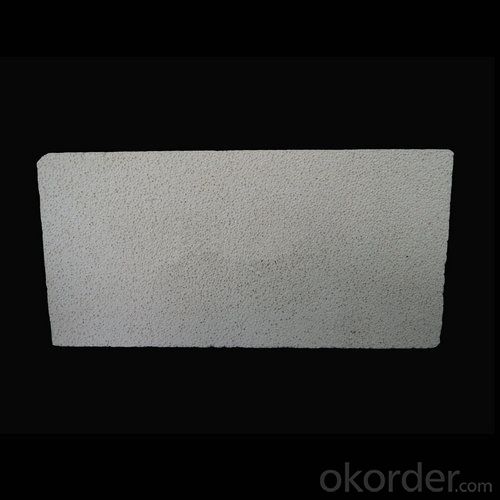
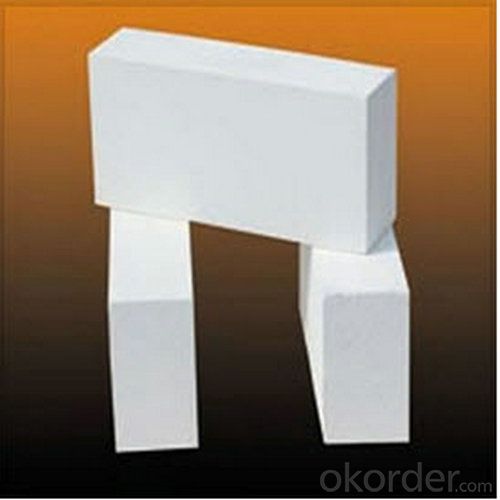
Applications of Insulating Fire Brick
1. Building materials for blast furnace
2. Building materials for hot-blast stove
3. Building materials for coke oven
4. Building materials for steel making furnace
5. For construction material in steel industry
6. For ladle
FAQ of Insulating Fire Brick
1. Which products do you have?
We have all kinds of refractory brick, castable, mortar, cement, ceramic fiber products, etc.
Or you could browse our products to choose what you need.
2. Can you give me a general idea of the specification and technical data of your products?
CNBM offer a range of refractory and insulation products. We provide refractory bricks, monolithic refractories as well as ceramic fiber products. And On your given shapes, drawings or description, we are producing refractories with all sizes and shapes, resistant to temperature from 800 °C till 1800 °C, using various machines and equipments for cutting, grinding, drilling, polishing, shaping processes.
Every refractory product by CNBM is of superior quality. Lesser refractory products can not approach. CNBM utilizes proprietary testing methods, testing for chemical content, density, apparent porosity, cold crush strength and modulus of rapture. With stringent quality control, you can count on CNBM products to exceed refractory industry standards and your expectations.
3. Can you give me a brief introduction of the application of your products?
We are mainly specializing in the refractory materials in iron and steel, cement, glass, ceramics, petrochemical, electric power Industry, etc.
4. If I need your offer, what information do you need?
In order to choose suitable products, it will be appreciated to provide us the information, such us specification, technical data, order quantity, products application etc.
If any question, please contact us freely.
- Q: Can insulating fire bricks be used as a refractory lining material?
- Yes, insulating fire bricks can be used as a refractory lining material. Insulating fire bricks are designed to have low thermal conductivity, which means they can effectively insulate against heat transfer. This makes them suitable for applications where high temperatures need to be maintained or controlled, such as in kilns, furnaces, and industrial ovens. Refractory lining materials are used to protect the structure of these high-temperature environments from the extreme heat generated inside. They need to be able to withstand the thermal shocks, chemical reactions, and mechanical stresses that occur during operation. Insulating fire bricks offer excellent thermal insulation properties, as well as high temperature resistance, making them an ideal choice for refractory lining applications. In addition to their insulating properties, insulating fire bricks also have low density, making them lightweight and easier to handle and install. This can be beneficial in applications where weight is a concern or where refractory linings need to be replaced or repaired frequently. It is important to note that the specific type and composition of insulating fire bricks may vary, and different applications may require different properties. Therefore, it is essential to consult with a refractory engineer or supplier to ensure the chosen insulating fire bricks are suitable for the specific requirements of the application.
- Q: Can insulating fire bricks be used in high-temperature insulation for aerospace applications?
- Insulating fire bricks are capable of being utilized for high-temperature insulation in aerospace applications. Constructed from lightweight refractory materials possessing exceptional insulating properties, these bricks can endure extreme temperatures. The bricks possess a low thermal conductivity, effectively decreasing heat transfer and maintaining the desired temperature within aerospace components. Within the realm of aerospace applications, environments of elevated temperatures are commonly encountered, such as within rocket engines, exhaust systems, and thermal protection systems. Insulating fire bricks can be employed in these applications to furnish thermal insulation, shielding delicate components from excessive heat and averting heat loss to the surroundings. Furthermore, insulating fire bricks are renowned for their exceptional resistance to thermal shock, thereby enabling them to endure sudden temperature changes without cracking or deteriorating. This attribute is of utmost importance in aerospace applications, where components undergo substantial temperature variations during launch, re-entry, or other operational phases. Moreover, insulating fire bricks possess lightweight characteristics, which can prove advantageous in aerospace applications where weight reduction is crucial for fuel efficiency and overall performance. By implementing insulating fire bricks, aerospace engineers can achieve efficient thermal insulation while minimizing the added weight to the system. All in all, insulating fire bricks constitute a viable solution for high-temperature insulation in aerospace applications. Their exceptional insulating properties, resistance to thermal shock, and lightweight nature render them suitable for safeguarding critical aerospace components within environments of extreme temperatures.
- Q: How do insulating fire bricks affect the overall fire resistance of a structure?
- Insulating fire bricks play a crucial role in enhancing the overall fire resistance of a structure. These specialized bricks are designed to withstand high temperatures and act as an effective thermal barrier. By insulating the structure, they help to reduce heat transfer and prevent the spread of fire. Insulating fire bricks possess a low thermal conductivity, which means they do not easily conduct heat. This property enables them to absorb and store heat energy, preventing it from being transmitted to other parts of the structure. As a result, the fire is contained within a specific area, minimizing the risk of spreading to adjacent areas. Furthermore, insulating fire bricks have a high melting point, making them extremely resilient to heat. This allows them to effectively withstand prolonged exposure to intense temperatures without deforming or disintegrating. By preserving their structural integrity, these bricks ensure the stability and integrity of the overall structure during a fire event. In addition to their insulation and heat resistance properties, insulating fire bricks also act as a barrier to flames and combustion gases. Their dense composition obstructs the passage of flames and smoke, preventing them from permeating through the structure. This containment helps to limit the damage caused by fire and provides valuable time for occupants to evacuate safely. Overall, the incorporation of insulating fire bricks in the construction of a structure significantly enhances its fire resistance. They provide insulation, prevent the spread of fire, maintain structural stability, and act as a barrier against flames and smoke. By reducing heat transfer and containing the fire, insulating fire bricks play a vital role in safeguarding the structure and its occupants during a fire emergency.
- Q: Can insulating fire bricks be used in the construction of foundry molds?
- Insulating fire bricks are capable of being utilized in the construction of foundry molds. These bricks are produced using lightweight materials like clay, alumina, and silica, and are specifically designed to possess low thermal conductivity. This quality renders them ideal for various applications that necessitate resistance against high temperatures and insulation, particularly foundry molds. Foundry molds are employed to shape and retain molten metal during the casting procedure. Given that molten metal is generally poured at exceedingly high temperatures, it becomes imperative to employ materials that can endure the heat without melting or distorting. Insulating fire bricks possess a high melting point and exceptional thermal stability, making them appropriate for usage in foundry molds. Furthermore, apart from their resistance to high temperatures, insulating fire bricks also offer commendable insulation properties. This proves to be crucial in foundry molds as it assists in regulating the cooling rate of the molten metal, thereby preventing thermal shock and ensuring proper solidification. The insulation properties of insulating fire bricks also contribute to lowering energy consumption and enhancing the overall efficiency of the foundry process. All in all, insulating fire bricks are an enduring and efficient choice for the construction of foundry molds. They provide resistance against high temperatures, excellent thermal stability, and reliable insulation properties, thus establishing themselves as a dependable option for employment in the demanding conditions of foundry operations.
- Q: What are insulation bricks for? Do not use high-rise buildings on the ah?
- Buildings usually do exterior thermal insulation, such as EPS board, polyphenyl board and so on
- Q: Can insulating fire bricks be used for insulation in sewage treatment plants?
- Yes, insulating fire bricks can be used for insulation in sewage treatment plants. Insulating fire bricks are specifically designed to withstand high temperatures and provide excellent insulation, making them suitable for use in environments where heat and moisture are present, such as sewage treatment plants. These bricks have low thermal conductivity, which helps to reduce heat loss and increase energy efficiency in the treatment process. Additionally, their resistance to chemicals and moisture makes them ideal for withstanding the corrosive environment found in sewage treatment plants. Therefore, insulating fire bricks can effectively provide insulation in sewage treatment plants, helping to maintain optimum operating temperatures and improve overall efficiency.
- Q: Can activated carbon be antiseptic?
- Activated carbon is also called activated carbon black. It is black, powder or lump, granular, cellular amorphous carbon, and also arranged crystal carbon.
- Q: Are insulating fire bricks suitable for use in kilns and furnaces?
- Yes, insulating fire bricks are suitable for use in kilns and furnaces. They are designed to have excellent insulation properties, which helps to reduce heat loss and improve energy efficiency in these high-temperature environments. Additionally, insulating fire bricks can withstand the extreme temperatures found in kilns and furnaces without cracking or breaking, making them a reliable and durable choice.
- Q: Can insulating fire bricks be custom-made?
- Indeed, it is possible to manufacture insulating fire bricks according to specific specifications. Typically, insulating fire bricks are crafted using lightweight materials like vermiculite, perlite, or refractory fibers, which are easily shaped into various forms and sizes. With this versatility, manufacturers can produce tailor-made insulating fire bricks to cater to specific demands and purposes. The customization options available may involve alterations in dimensions, thermal conductivity, compressive strength, and density. By adjusting the composition and design of the insulating fire bricks, they can be optimized to function optimally within specific temperature ranges, insulation requirements, and environmental conditions. Consequently, customers have the opportunity to collaborate with manufacturers in order to develop personalized solutions that perfectly align with their individual requirements.
- Q: Can insulating fire bricks be used in kiln car construction?
- Insulating fire bricks, which are manufactured using lightweight materials like ceramic fibers or lightweight refractory aggregates, can be utilized in the construction of kiln cars. These bricks possess exceptional insulating properties and have a low thermal conductivity, enabling them to effectively retain heat and prevent heat transfer to the outer surface of the kiln car. Incorporating insulating fire bricks into kiln car construction offers numerous advantages. Firstly, it aids in reducing heat loss, thereby enhancing energy efficiency and reducing fuel consumption. This benefit is especially significant in high-temperature applications such as kilns, where maintaining a consistent temperature is of utmost importance. Secondly, the utilization of insulating fire bricks helps safeguard the kiln car from thermal stresses and cracking. Due to the firing cycles, kilns experience substantial temperature fluctuations, and the presence of insulating fire bricks minimizes thermal shock, consequently prolonging the lifespan of the kiln car. Additionally, insulating fire bricks are notably lighter compared to conventional refractory bricks, making them more manageable and easier to install during kiln car construction. This, in turn, can result in cost savings related to labor and transportation expenses. However, it is crucial to note that insulating fire bricks possess lower strength and durability when compared to denser refractory bricks. Therefore, they are typically used in the hot face lining of kilns, while a more robust material is employed for the kiln car structure. In summary, the effective utilization of insulating fire bricks in kiln car construction can yield benefits such as improved energy efficiency, protection against thermal stresses, and overall enhancement of kiln performance.
Send your message to us
Insulating Fire Brick 65% Al2O3 min High Alumina
- Loading Port:
- Tianjin
- Payment Terms:
- TT OR LC
- Min Order Qty:
- 1 m.t.
- Supply Capability:
- 20000 m.t./month
OKorder Service Pledge
OKorder Financial Service
Similar products
Hot products
Hot Searches
Related keywords
